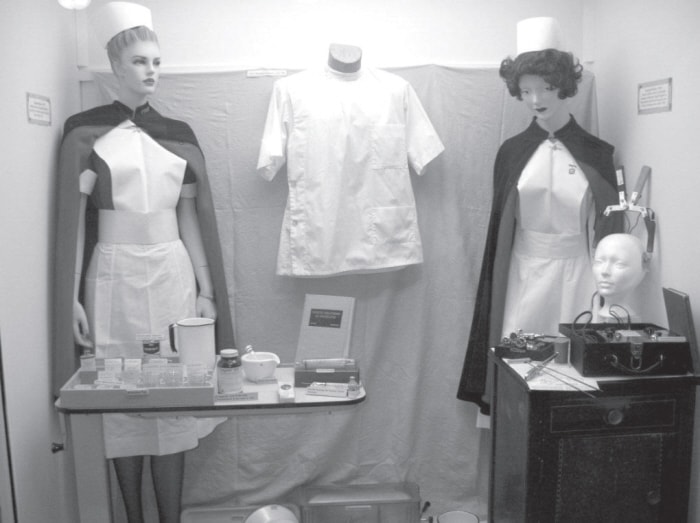At the age of 95, my dad still asks me about the Provincial Mental Hospital (now Centennial Centre), where he worked from 1948 until his retirement in the late 1970s. He still remembers most of the staff and patients that he worked with over the years, first on the wards, and then for many joyous years at the good old Recreation Hall.
During his close to 30 busy years at the hospital, we also grew as a little family here in Ponoka, and will always share the memories of the countless friends, neighbours, experiences and activities that we enjoyed in and around this great and caring community. Now retired in Victoria, B.C. with my step-mother Jean, our family is still very close, we visit as much as possible, and I try to send out lots of photos and stories of his always favourite home town.
In the latter part of his career, my dad gathered a group together and spearheaded an enthusiastic project to put together a museum collection dedicated to the preservation and the proud colorful history of the Provincial Mental Hospital from 1911 and on through the years. With the help and enthusiasm of staff members and departments from all areas of the massive psychiatric treatment and teaching facility, hundreds of artifacts and information were slowly collected, then carefully put on display in the upstairs of the main heritage building. This historical red brick structure was one of the original buildings of the initial construction, and still remains today on the present grounds of the ultra modern Centennial Centre for Mental Health and Brain Injury.
The hospital museum would become an instant and ongoing success, attracting hundreds of past and present staff, patients and relatives and visitors from far and wide to enjoy the amazing collection, to realize the exciting history, celebrate the ongoing progress, growth and successes, as well as to salute the extreme contributions and care from decades of staff members. As new phases of treatment and expansion plans began to take place at the prestigious psychiatric facility in the 1990s, many of the old buildings were demolished, and when construction and renovations began, the precious museum collection was moved into storage in Edmonton.
Thankfully, the hospital museum collection was never forgotten, and with the kind perseverance of past and present Alberta hospital staff and the community, and the energetic lobbying of popular Ponoka/Wetaskiwin constituency MLA Halvor Jonson, most of the artifacts were returned in 2004 to a new and permanent home at the Fort Ostell Museum.
Here are just a few of the highlights of this fabulous collection, which will be of great interest to all generations, as well as bringing back many fond memories to those whose family members worked at the hospital over the years, to those of us who grew up on the grounds, and to a town and county who appreciates how much this first class psychiatric facility has meant to the community, and to our province and our nation:
● As you walk into the lobby of the Fort Ostell Museum in the north-west corner of the Ponoka Lion’s Centennial Park, you will be warmly greeted by the congenial staff and asked to sign the guest book. The first large display case will feature 1946 and 1952 P.M.H. student and graduate nurses modeling their always stiff and starchy but classy uniforms and caps while performing their duties, as well as a 1960 male attendant’s coat. Also shown are the hospital’s first electro shock machine, medicine trays, a very large syringe, and a bottle of Epsom Salts, which was used for everything in those days;
● Along all the front lobby walls and on the shelves in the Ponoka museum meeting room are hundreds of photos, documents and medical records outlining the early history, treatment methods and steady progress of the Provincial Mental Hospital from its opening on July 4, 1911 on through the decades. Another vivid display features the tight security measures of the beginning years, including straight jackets and collars, as well as a ladies‘ restraining dress, but all those restraints were eliminated by 1936 when modern day drugs and advanced treatments were introduced to calm down the patients. Other additions to the hospital care at the Provincial Mental Hospital included an Insulin Unit in 1937, a fully equipped lab, x-ray, and dental office, and advanced methods of the use of tranquilizing drugs and group therapy. The highest patient count in the history of the hospital was 1600 in the 1940s, which resulted in countless challenges to the staff, as well as the desperate need for new buildings and equipment;
● Another display case that really made yours truly shiver contained a set of cold stainless steel instruments which included a tonsil snare and remover, bone nibbler, amputation saw, uterine probe, lobotomy mallet and on and on. Visitors will also get a peak at the large keys that the staff used, as well as identical keys and tools that were made in secrecy by the patients out of wood, soap, bones, and plastic and often used to try and escape;
● Along with the very interesting hospital museum collection, there are also many other great displays at Fort Ostell of the long and colorful history of our town and district that visitors are invited to casually browse through and ask as many questions as they wish.
